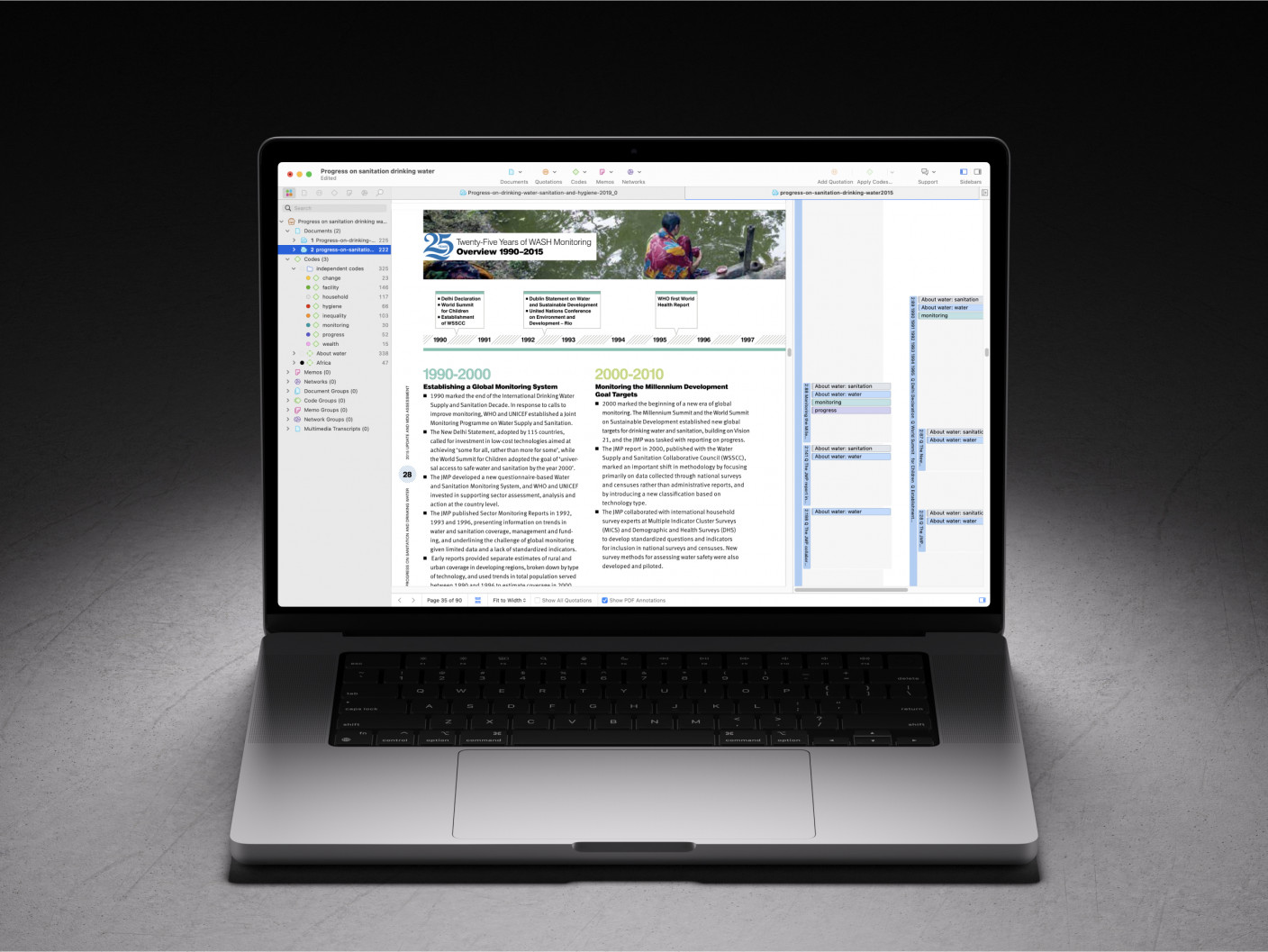- What is Mixed Methods Research?
- Advantages of Mixed Methods Research
- Challenges in Mixed Methods Research
- Common Mistakes in Mixed Methods Research
- Mixed Methods Research Paradigms
- Validity & Reliability in Mixed Methods Research
- Ethical Considerations in Mixed Methods Research
- Mixed Methods vs. Multiple Methods Research
- Mixed Methods Research Designs
- How to Choose the Right Mixed Methods Design
- Convergent Parallel Design
- Explanatory Sequential Design
- Exploratory Sequential Design
- Embedded Mixed Methods Research Design
- Transformative Mixed Methods Design
- Multiphase Mixed Methods Research Design
- How to Conduct Mixed Methods Research
- Sampling Strategies in Mixed Methods Research
- Data Collection in Mixed Methods Research
- Triangulation in Mixed Methods Research
- Data Analysis in Mixed Methods Research
- How to Integrate Quantitative & Qualitative Data?
- How to Interpret Mixed Methods Research Findings?
- Software Tools for Mixed Methods Data Analysis
- How to Write a Mixed Methods Research Proposal
- How to Write a Mixed Methods Research Paper?
- Reporting Results in Mixed Methods Research
- Mixed Methods Research Examples
- How to cite "The Guide to Mixed Methods Research"
How to Interpret Mixed Methods Research Findings?
After a researcher finishes analyzing mixed methods research data, next is interpretation, which refers to making sense of qualitative and quantitative data, separately and together, to generate meaningful conclusions. It plays a crucial role in understanding, synthesizing, and explaining research findings.

Introduction
Interpretation in mixed methods research involves analyzing qualitative and quantitative data and integrating the two to form a cohesive understanding of the research problem. Unlike single-method studies, where interpretation focuses solely on one type of data, mixed-methods research requires a systematic approach to making sense of numerical and textual findings.
Teddlie and Tashakkori (2009) refer to integration as the process of drawing inferences and meta-inferences. Inferences are conclusions derived from each of the qualitative or quantitative strands of a study, while meta-inferences emerge from integrating both datasets. The goal of mixed methods interpretation is to provide insights beyond what could be gained from qualitative or quantitative data alone.
Key aspects of interpretation in mixed methods research
Interpretation requires careful consideration of statistical trends, thematic insights, and broader research implications while maintaining rigor. Below are four key aspects of interpretation in mixed methods research, each playing a crucial role in ensuring that the study's conclusions are credible and contribute meaningful insights.
Occurs in multiple stages
Interpretation in mixed methods research is not a single-step process; rather, it happens before and after integration, each serving a different purpose. Before integration, qualitative and quantitative datasets are analyzed separately within their respective methodological frameworks. For instance, quantitative data interpretation involves statistical techniques such as regression analysis, correlation, or descriptive statistics to identify patterns and relationships. On the other hand, qualitative data interpretation relies on thematic analysis, grounded theory, or content analysis to extract meaning from narratives, interviews, or open-ended responses. These initial interpretations are essential because they provide a clear understanding of the individual datasets before merging them.
After integration, interpretation moves to a higher level, where researchers synthesize and compare findings to develop meta-inferences—broader conclusions that arise from the interaction between qualitative and quantitative data. At this stage, researchers determine whether the datasets converge (support each other), diverge (contradict each other), or complement each other by filling in gaps. For example, if survey data (quantitative) suggests that students perform better in structured learning environments, but interview data (qualitative) reveals that students find such environments restrictive, the interpretation must address these differences. Researchers must explain how and why these findings relate to each other, rather than simply reporting them side by side. Thus, interpretation occurs at multiple stages, ensuring that each dataset is understood independently before being synthesized into a more comprehensive understanding of the research topic.
Relates to the research question
A crucial aspect of interpretation is ensuring that findings are always linked to the study’s research question. Mixed methods research often generates a large amount of data, and without a clear connection to the research objectives, findings can become disjointed, unfocused, or overwhelming. Effective interpretation requires researchers to actively align qualitative and quantitative findings with the central question of the study to ensure that they provide meaningful and actionable insights.
For example, suppose a study is investigating the impact of remote work on employee productivity. The research question might be: "How does remote work influence productivity and job satisfaction among employees?" The quantitative component (such as surveys or time-tracking data) might indicate that employees working remotely log more hours than those in office settings. Meanwhile, the qualitative component (such as employee interviews) may reveal that remote employees feel more productive but also more isolated. A researcher interpreting these results must ensure that they do not just present both findings separately but instead connect them back to the research question. In this case, the interpretation might conclude that while remote work increases logged work hours, it also introduces challenges related to employee well-being and engagement, which could impact long-term productivity.
Failing to link findings to the research question could lead to fragmented conclusions that do not address the core issue. Thus, interpretation must always be conducted with the study’s objectives, hypothesis, or guiding questions in mind to ensure that the research remains focused and relevant.
Considers multiple perspectives
One of the defining features of mixed methods research is its ability to capture multiple perspectives by integrating numerical (quantitative) and descriptive (qualitative) data. However, this presents a unique challenge: how do researchers make sense of findings that emerge from different analytical traditions? Interpretation must bridge this gap by recognizing the value of each method while ensuring that one does not dominate the other.
Quantitative data is often broad and generalizable, helping researchers understand trends across large populations. However, it lacks contextual depth—it does not explain why certain patterns emerge. Conversely, qualitative data provides deep insights into individual or group experiences but may not be statistically representative. Effective interpretation must ensure that these perspectives are balanced rather than privileging one type of data over another.
For example, in a study on patient satisfaction in hospitals, researchers might find that survey results (quantitative) show that 85% of patients report being satisfied with their care. On the other hand, interviews (qualitative) may reveal that some patients felt rushed during consultations and wished for more time with their doctors.
If interpretation only focuses on the high satisfaction percentage, it may overlook important concerns about doctor-patient interactions. On the other hand, if it only emphasizes the negative experiences from interviews, it may give a misleading impression that most patients are dissatisfied. Instead, researchers must integrate both perspectives to provide a nuanced interpretation—for example, stating that while overall satisfaction is high, certain aspects of patient care, such as consultation time, may still need improvement.
Thus, mixed methods interpretation requires careful attention to statistical trends and narrative insights, ensuring that no perspective is lost or misrepresented.
Requires rigor
Interpretation in mixed methods research must be rigorous, systematic, and transparent. Because mixed methods research often involves subjective judgment, there is a risk of confirmation bias, where researchers unconsciously prioritize findings that align with their expectations or hypotheses. To avoid this, interpretation must be methodical and well-documented.
A rigorous approach to interpretation includes:
- Using clear frameworks: Researchers should employ established interpretation strategies such as convergent interpretation (comparing aligned results), explanatory interpretation (using one dataset to explain the other), or contradictory interpretation (resolving conflicting findings).
- Triangulating findings: Comparing data across different sources increases credibility and ensures that conclusions are not based on a single dataset.
- Acknowledging limitations: Researchers should transparently report gaps, inconsistencies, or potential weaknesses in their interpretation process.
For example, in a study on student engagement in online learning, suppose survey data (quantitative) indicates that 78% of students feel engaged. On the other hand, interviews (qualitative) reveal that students feel overwhelmed by self-paced learning.
A weak interpretation would only emphasize the high engagement percentage, ignoring the concerns raised in interviews. A rigorous interpretation would critically evaluate both datasets and acknowledge that while students report engagement in surveys, qualitative findings suggest that some may feel pressure to perform, which could affect long-term engagement levels.
By maintaining systematic analysis, transparency, and critical evaluation, researchers ensure that interpretation is robust, credible, and free from undue bias.
Challenges in interpretation
Researchers may face several challenges when trying to integrate findings, ensure methodological rigor, and construct a meaningful narrative. Below are some common challenges along with practical solutions to improve the interpretation process.
Aligning qualitative and quantitative paradigms
Qualitative and quantitative research follow different philosophical traditions—quantitative research is often positivist (seeking objective truths through statistical patterns), while qualitative research is often constructivist (seeking to understand human experiences and interpretations). This fundamental difference can make integration difficult, as researchers may struggle to reconcile statistical trends with in-depth personal narratives.
A good solution is to use a pragmatic approach which focuses on answering the research question rather than being constrained by methodological differences. Instead of treating qualitative and quantitative data as competing paradigms, researchers should view them as complementary lenses.
- Apply a research-driven approach: Use the data type that best answers each aspect of the research question.
- Use theoretical frameworks: Mixed methods models (e.g., convergent, explanatory, exploratory) provide structured ways to combine datasets.
- Acknowledge epistemological differences: Be transparent about the strengths and limitations of each method when drawing interpretations.
Conflicting findings
It is common for qualitative and quantitative findings to contradict each other. For example, a survey (quantitative) may show that employees report high job satisfaction, but interviews (qualitative) might reveal frustration and dissatisfaction with certain management policies.
Rather than ignoring conflicting results, researchers should embrace discrepancies and explore possible explanations.
- Triangulation: Compare findings with additional sources of data (e.g., observations, document analysis) to determine which aspects of the phenomenon each perspective explains.
- Follow-up analysis: Conduct further qualitative interviews to clarify contradictions or use statistical subgroup analysis to detect variations in survey responses.
- Mixed interpretation models:
Convergent interpretation: Examine where datasets support each other.
Contradictory interpretation: Identify reasons for conflicts (e.g., social desirability bias in surveys, sampling differences, or contextual factors).
Differing levels of detail
Quantitative findings tend to be broad but shallow, while qualitative findings are rich but narrow. This mismatch can make it difficult to integrate data meaningfully.
To balance the depth of qualitative data with the breadth of quantitative findings, researchers can convert one type of data into another:
- Quantifying qualitative data: Convert qualitative themes into numerical categories (e.g., coding interview responses into percentages of positive/negative sentiment).
- Qualitizing quantitative data: Use case studies or participant narratives to illustrate statistical trends in a human-centered way.
Time and resources
Interpretation in mixed methods research requires expertise in both statistical and qualitative analysis, making it time-consuming. Large datasets and complex integration strategies can also require advanced software, transcription services, and data visualization tools. To assist with this, the use of software like NVivo and ATLAS.ti can help interpretation by providing visualization tools such as word frequency diagrams, code co-occurrence tables, and other features that facilitate quantifying qualitative data or converting qualitative findings into formats that can be statistically analyzed. AI-powered tools can help with thematic coding, transcription, and sentiment analysis to speed up qualitative interpretation. Also, establishing a coding guide for qualitative data and predefined statistical analysis methods can streamline interpretation.
The two stages of interpretation
Interpretation in mixed methods research occurs in two key stages:
- Before integration, where qualitative and quantitative datasets are analyzed separately.
- After integration, where data is synthesized to develop meta-inferences.
Each stage serves a distinct purpose, ensuring that findings are first understood independently and then integrated into a cohesive narrative. Below is an in-depth examination of these two stages.
Interpretation before integration
Before integrating qualitative and quantitative data, each dataset must be interpreted within its methodological framework. This stage ensures that findings from both data types are rigorously analyzed and understood in their context before being combined.
Key features of pre-integration interpretation
- Analysis happens separately: Quantitative data is analyzed using statistical techniques, while qualitative data is examined using qualitative methods, such as thematic, content, or narrative analysis.
- Findings remain independent: At this stage, no attempt is made to merge or connect data.
- Ensures methodological rigor: Interpretation must follow established analytical approaches.
- Provides preliminary insights: Researchers begin to identify key patterns, trends, and themes before integration.
Quantitative data interpretation before integration
Quantitative data interpretation focuses on statistical patterns, relationships, and numerical trends. The goal is to extract meaning from numerical data using various statistical techniques.
Methods that could be used include descriptive statistics (mean, median, standard deviation), inferential statistics (t-tests, regression, ANOVA, correlations), and multivariate analysis (factor analysis, structural equation modelling)
Qualitative data interpretation before integration
Qualitative data interpretation focuses on identifying themes, patterns, and deeper meanings within participant responses. The goal is to extract insights from interviews, focus groups, or open-ended survey responses.
Methods that could be used include thematic analysis (identifying recurring topics), grounded theory (developing theories from data), and narrative analysis (examining participant stories).
Importance of interpretation before integration
This stage is important because it makes sure that each dataset is analyzed rigorously before integration. It also bolsters credibility by preventing one method from influencing the other prematurely and provides independent insights that researchers can compare and contrast.
In this stage, researchers do not try to reconcile the findings by ensuring that each dataset is strong on its own and preparing it for integration.
Common strategies
Interpreting integrated data in mixed methods research requires researchers to use structured strategies to make sense of qualitative and quantitative findings in a meaningful way. Four primary integration strategies guide this process: convergent, explanatory, exploratory, and contradictory interpretation.
Convergent interpretation occurs when qualitative and quantitative findings support or reinforce each other, confirming the same conclusion. For example, if a survey reveals that 80% of students report high satisfaction with online learning, and interviews indicate that students appreciate the flexibility of online courses, these findings align to provide a stronger, more validated insight.
Explanatory interpretation, on the other hand, involves using qualitative findings to provide deeper meaning to quantitative results. A study might find that students who spend more time studying tend to have higher grades (quantitative), and follow-up interviews could reveal that students who create structured study plans feel more confident in their learning (qualitative), explaining the statistical trend.
Exploratory interpretation works in the opposite direction, where quantitative findings clarify or expand upon qualitative insights. If interviews suggest that students struggle with time management in online courses, a subsequent survey could quantify this, revealing that 65% of students report distractions at home as a major challenge.
Finally, contradictory interpretation arises when qualitative and quantitative findings diverge or conflict, requiring deeper analysis. For instance, a survey might indicate that employees report high job satisfaction, but interviews could reveal frustrations with workload and management. In such cases, researchers must explore potential reasons for discrepancies, such as social desirability bias in surveys, differences in sampling, or hidden contextual factors.
By systematically applying these integration strategies, researchers can develop well-rounded interpretations that acknowledge numerical trends and lived experiences, ultimately leading to more comprehensive conclusions.
Importance of post-integration interpretation
Interpretation after integration is important because it ensures that data is reported separately but integrated meaningfully. It also helps researchers resolve discrepancies and contradictions between datasets, leading to richer, more actionable insights that neither dataset alone could provide.
Conclusion
Interpreting quantitative and qualitative data in mixed methods research requires a structured approach to ensure that quantitative research methods and qualitative insights contribute to a meaningful understanding of the research problem. Unlike single-method studies, conducting mixed methods research involves analyzing datasets separately before integrating them to develop a comprehensive interpretation. By carefully considering both quantitative and qualitative research, researchers can move beyond isolated statistical trends or individual narratives to form a more complete understanding of their study’s results.
A well-executed mixed methods approach enables researchers to collect quantitative data through structured quantitative methods such as surveys and experiments, while qualitative findings from interviews, focus groups, open-ended responses, or other types of qualitative data provide deeper context. The integration of these datasets allows for a more nuanced exploration of relationships and explanations, ensuring that findings are not only statistically valid but also contextually meaningful. However, ensuring coherence in interpretation requires researchers to apply appropriate integration strategies, whether through convergent, explanatory, exploratory, or contradictory models.
Ultimately, effective interpretation of quantitative data collection in mixed methods research is not just about merging numbers with narratives—it is about synthesizing diverse data sources in a way that aligns with the study’s research question. By applying structured interpretation techniques and maintaining methodological rigor, researchers can derive meaningful insights that enhance both theoretical understanding and practical application in their respective fields.


